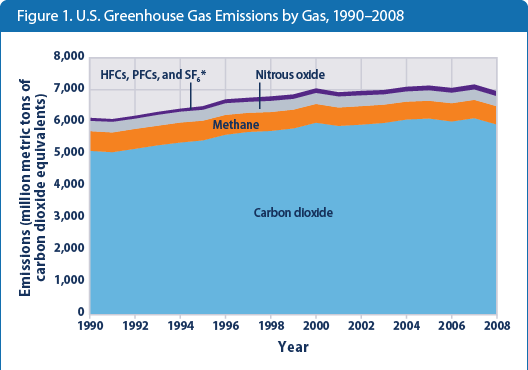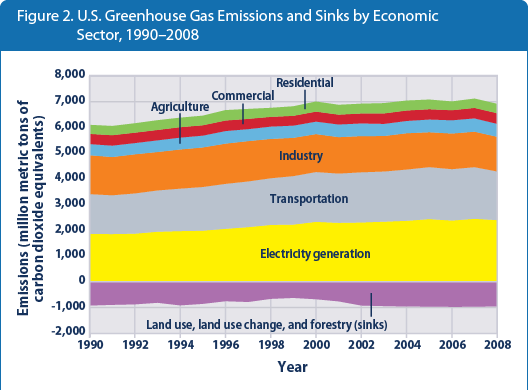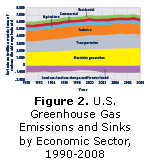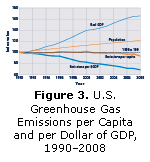Climate Change
Climate Change Indicators in the United States

This figure shows emissions of carbon dioxide, methane, nitrous oxide, and several fluorinated compounds in the United States from 1990 to 2008. For consistency, emissions are expressed in million metric tons of carbon dioxide equivalents.
* HFCs are hydrofluorocarbons, PFCs are perfluorocarbons, and SF6 is sulfur hexafluoride.
Data source: U.S. EPA, 2010. 3

This figure shows greenhouse gas sinks and emissions by source in the United States from 1990 to 2008. For consistency, emissions are expressed in million metric tons of carbon dioxide equivalents. Totals do not match Figure 1 exactly because the economic sectors shown here do not include emissions from U.S. territories.
Data source: U.S. EPA, 2010 4

This figure shows trends in greenhouse gas emissions from 1990 to 2008 per capita, based on the total U.S. population (heavy orange line). It also shows trends in emissions compared with the real GDP, which is the value of all goods and services produced in the country during a given year, adjusted for inflation (heavy blue line). All data are indexed to 1990 as the base year, which is assigned a value of 100; thus a value of 140 in 2000 would represent a 40 percent increase since 1990.
Data source: U.S. EPA, 2010 5
Key Points
- In 2008, U.S. greenhouse gas emissions totaled 6,957 million metric tons of carbon dioxide equivalents, a 14 percent increase from 1990 (see Figure 1).
- During the period from 1990 to 2008 (see Figure 1):
- Emissions of carbon dioxide, the primary greenhouse gas emitted by human activities, increased by 16 percent.
- Emissions of fluorinated compounds, released as a result of commercial, industrial, and household uses, rose by 66 percent. Although fluorinated gases accounted for only 2 percent of all greenhouse gas emissions in 2008, they are important because they have extremely high global warming potential values and long atmospheric lifetimes.
- Methane emissions decreased by 7 percent, largely because of reduced emissions from landfills and coal mines. 2
- Nitrous oxide emissions, largely derived from agricultural soil management, nitrogen application, and vehicle emissions, declined by 1 percent.
- Electricity generation has accounted for about 32 percent of total U.S. greenhouse gas emissions since 1990. Transportation is the second largest source of greenhouse gas emissions, accounting for 27 percent of emissions since 1990 (see Figure 2).
- In 2008, 14 percent of U.S. greenhouse gas emissions were offset by uptake of carbon and "sequestration" in forests, trees, agricultural soils, and landfilled yard trimmings and food scraps (these are referred to as sinks, as shown in Figure 2 beneath the axis).
- Emissions per capita have remained nearly level since 1990 (see Figure 3), as emissions have increased at about the same rate as the population.
- From 1990 to 2008, greenhouse gas emissions per unit of U.S. GDP declined by 31 percent (see Figure 3).
Background
A number of factors influence the quantities of greenhouse gases released into the atmosphere, including economic activity, population, income level, energy prices, land use, technology, and weather conditions. There are several ways to track these emissions. In addition to tracking overall emissions and emissions from specific industrial sectors in absolute terms, many countries also track emissions per capita.
Methods to reduce greenhouse gas emissions include fuel switching (such as switching from fossil fuels to wind power); conservation and energy efficiency; and methane recovery from emission sources such as landfills and coal mines.
About the Indicator
This indicator focuses on emissions of carbon dioxide, methane, nitrous oxide, and several fluorinated compounds—all important greenhouse gases that are influenced by human activities. These particular gases are covered under the United Nations Framework Convention on Climate Change, an international agreement that requires participating countries to develop and periodically submit an inventory of greenhouse gas emissions. Data and analysis for this indicator come from EPA's Inventory of U.S. Greenhouse Gas Emissions and Sinks: 1990-2008. 1
This indicator reports emissions of greenhouse gases according to their global warming potential, a measure of how much a given amount of the greenhouse gas is estimated to contribute to global warming over a selected period of time. For the purposes of comparison, global warming potential values are given in relation to carbon dioxide and are expressed in terms of carbon dioxide equivalents. For additional perspective, this indicator also shows greenhouse gas emissions in relation to economic activity and population.
Indicator Confidence
While this indicator addresses many of the most important greenhouse gases, it does not include other gases that are not covered under the United Nations Framework Convention on Climate Change but could still affect the Earth's energy balance and climate (see the Climate Forcing indicator for more details). For example, this indicator excludes ozone-depleting substances such as chlorofluorocarbons (CFCs) and hydrochlorofluorocarbons, which have high global warming potentials, as these gases are being phased out under an international agreement called the Montreal Protocol. There also are a variety of natural greenhouse gas emission sources; however, this indicator includes only man-made and human-influenced greenhouse gas emissions.
Data Sources
Data for this indicator came from EPA's Inventory of U.S. Greenhouse Gas Emissions and Sinks: 1990–2008. This report is available online at: www.epa.gov/climatechange/ emissions/usinventoryreport.html. The calculations in Figure 3 are based on gross domestic product (GDP) and population data provided by the U.S. Bureau of Economic Analysis and the U.S. Census, respectively.
Indicator Documentation
- Download related technical information PDF (6 pp, 44K)





